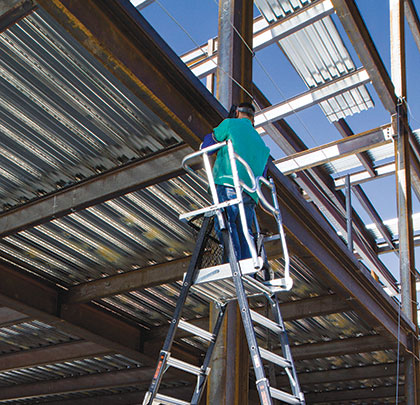How should we inspect our ladders? And who should do it”? These are a couple of the most common questions heard at ladder safety classes. According to OSHA, ladders must be inspected by a competent person for visible defects on a periodic basis and after any occurrence that could affect their safe use (1926.1053). This brings up two important questions: Who is a “competent person?” And what does “periodic basis” mean?
COMPETENT PERSON
OSHA says competent person means one who is capable of “identifying existing and predictable hazards in the surroundings or working conditions which are unsanitary, hazardous, or dangerous to employees, and who has authorization to take prompt corrective measures to eliminate them.” (1926.32)
The competent person who inspects your fall-protection gear might not be considered competent to inspect ladders—or anything else—if they lack specific training or experience. Being considered a competent person in one thing doesn’t make you competent in all things.
PERIODIC BASIS
Every 10 years is a periodic basis, but I’m pretty sure that’s not what they mean in the standard. They define it a little better in another part of the standard 1910.27(f): “All ladders shall be inspected regularly, with the intervals between inspections being determined by use and exposure.” A little better, yes, but still not crystal clear. I recommend that periodic or regularly means at least every year, unless excess use and exposure require it to be more frequent.
I’ve had some contractors say “all my workers are competent and they inspect their ladder every time they use it, so I’m covered.” I’m not sure the plaintiff attorney’s next statement would be “no further questions.” But rather, “how do you know if they know what to look for? And where is your record of inspection? If it’s not written down, you didn’t do it.” Yes, the user should inspect their ladder every time they use it, but that’s different than the periodic competent inspection.
The user should inspect the ladder before each use. And on a regular basis, a properly trained competent person who knows what to look for and has authority to correct the problem should inspect the ladder. The competent person should also record and file the inspection. There is a good ladder inspection checklist available from the American Ladder Institute at www.laddersafety.org.
What exactly should a competent person look for?
FEET/SHOES
The feet on your ladder are like the tires on your vehicle. They are made of soft plastic or rubber for better traction but soft material wears out and needs to be replaced. If the tread on your ladder feet are worn out, change them.
SIDE RAILS AND RUNGS
If it’s cracked, bent, or broken, it’s bad and needs to be destroyed so no one could possibly use it again. There are plenty of cases where companies lost a lawsuit because someone took a bad ladder out of their dumpster and was hurt on it—crazy, but true.
When your ladders fade and discolor in the sunlight, we call it “fiber bloom.” Fiber bloom becomes a problem when the material starts to crack or split and you get fiberglass slivers in your hands. Also, check that the rung-to-siderail connection is tight.
STICKERS
Keep the labels clean, and if they get rubbed off, replace them. It’s a good idea when inspecting your ladders that you look at the ladder racks to make sure they are well padded and not causing damage in transport.
EVERYTHING ELSE
Nuts, bolts, rivets, braces, spreaders, latches, and ropes; all should be in good condition, free from rust and working properly.
Why all this work for a ladder? Falls are the leading cause of injury and fatality in the workplace, and ladders are involved in more than half of those cases. Ladders are safety equipment and should be treated as such. ■
For More Information:
If you are interested in free ladder safety training or competent ladder inspector training, contact David Francis, national safety director, with Little Giant Ladder Systems at dave@ladders.com or 801.362.8586. For more information, visit www.laddersafetyhub.com.
_________________________________________________________________________
Modern Contractor Solutions, October 2013
Did you enjoy this article?
Subscribe to the FREE Digital Edition of Modern Contractor Solutions magazine.

Competent Ladder Inspectors: A Must-Have for the Jobsite


